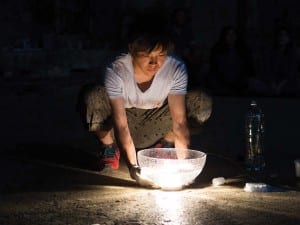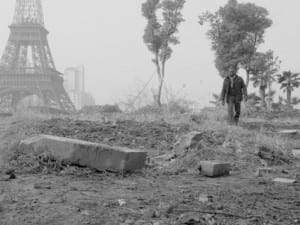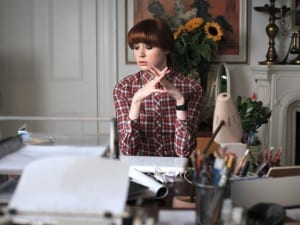What are the boundaries between musical instruments and artistic practice? How can one define the properties and influence of sound over our senses? Fondazione Prada’s exhibition at the magnificent neoclassical palace of Ca’ Corner della Regina in Venice takes us on a remarkable journey of art and sound.
Curated by Italian art critic and historian Germano Celant, who coined the term ‘Arte Povera’ back in 1967, the exhibition dominates the venue’s two floors. Encompassing a collection of fascinating instruments from the 17th century onwards, the show’s narrative introduces us to the imaginative spirit and creative intellect of device makers. By employing not just precious stones but also developing an array of ingenious mechanical apparatus -automata- and incorporating human and animal iconography, these artisans left a legacy of works that stimulated artists in the centuries to come.
Curious artefacts on display embrace daunting visual as well as astonishing acoustic effects. The Singing Birdcage with Clock (c. 1790) by Swiss clockmaker Pierre Jaquet-Droz, the Clock with Flutes (c.1800), the Pyrophone (c.1876) by Georges Frédéric Kastner and the Snake Charmer Automaton (1890) by toy producer Roullet-Decamps are great samples of the progress and evolution in the field of acoustic music, leading the way to the sophisticated experimentations of the 20th century.
Pietro Verardo’s reconstruction of Luigi Russolo’s Intonarumori (1913-14) is a representative of a new cohort of noise generating devices. Influenced by the industrial revolution and embodying atonal sounds from its contemporary world, this type of iconic futurist appliance has inspired artistic and musical research to the present date such as that of composer Iannis Xenakis. Other concurrent investigations during the first half of the 20th century incorporate the musical readymades of Marcel Duchamp (With Hidden Noise, 1916) and Man Ray (Indestructible Object, 1923 and Emak Bakia, 1926), as well as the kinetic sculptures of Alexander Calder (Untitled, c.1940). Henrik Neugeboren’s survey on the neurological phenomenon of synaesthesia (Sculptural representation of bars 52-55 of E-flat Minor Fugue by J.S. Bach, 1928) explores music and its transition through more than one senses, a concept that also engaged, amongst others, Nabokov, Kandinsky, Mondrian, Scriabin and Messiaen.
A significant part of the Fondazione Prada’s show also pays tribute to electro-acoustic music and some related avant-garde movements such as Fluxus. The works of John Cage (Variations I, 1985), Joe Jones (Bird Cage, 1963), Wolf Vostell (Radar Alarm, 1969), George Maciunas (Piano Piece, 1970) and Takako Saito (Sound Chess, c.1977) are exponents of a profound investigatory process with sound actively intertwined with the human body and its senses.
Emphasising the high significance of personal participation, interaction is a vital part of the exhibition. Visitors are encouraged to experience certain works themselves and put their senses to the test. In Bernhard Leitner’s Sound Chair (Ton Liege, 1975) the reclining listener feels cello and hom sounds permeating the body. Similarly, music travels through the listener’s elbows while placing them on Laurie Anderson’s Handphone Table (1978). In Carsten Nicolai’s Bausatz Noto (1998) visitors are welcome to produce their own music via the conduit of turntables.
The gigantic speaker Toyan’s Jr. (2001) by Tom Sachs, the automaton Senza Titolo (2003) by Maurizio Cattelan, the striking phonoharp Phonosarangi (2005) by Walter Kitundu, and the installations of Anri Sala (A Solo in the Doldrums, 2009), Tarek Atoui (The Metastable Circuit, 2012) and Haroon Mirza (Stack, 2013), are further sound experimentations in dialogue with advanced technological applications and engineering.
Such an extensive retrospective of the history of soundscape could not possibly bypass the element of performance. Although I visited on a weekday with no special events taking place, I was informed that several artworks are frequently brought to life by performers and artists. I am pretty confident that being able to witness this would be a great experience and also a way to thoroughly perceive the evolution and subsequent advancements in the vast domain of music.
Art or Sound is a major discourse on the aesthetics of music and its trajectory, consistently interrelated with social and economic change throughout the centuries. The impact of music on our senses -even those emerging studies focusing on its healing properties- attest its vigorous connection with the human hypostasis. I departed the exhibition enthused, visually and emotionally energised; a must see for the lucky ones to be in Venice until early November.
Kostas Prapoglou
Art or Sound at Fondazione Prada, Calle de Ca’ Corner, Santa Croce 2215 – 30135 Venice www.prada.com
Credit:
1 & 2: Installation shots of Art or Sound courtesy of Fondazione Prada
Follow us on Twitter @AestheticaMag for the latest news in contemporary art and culture




